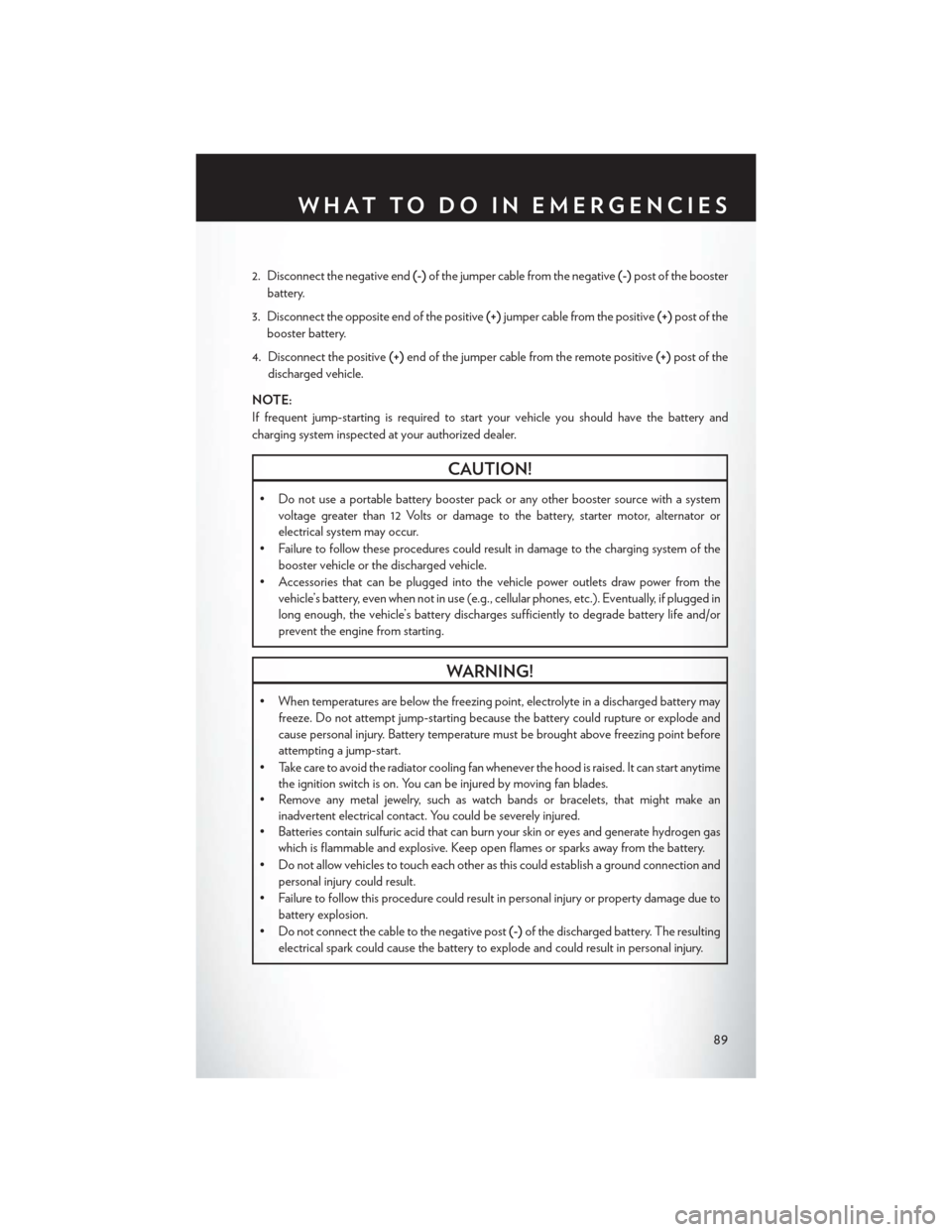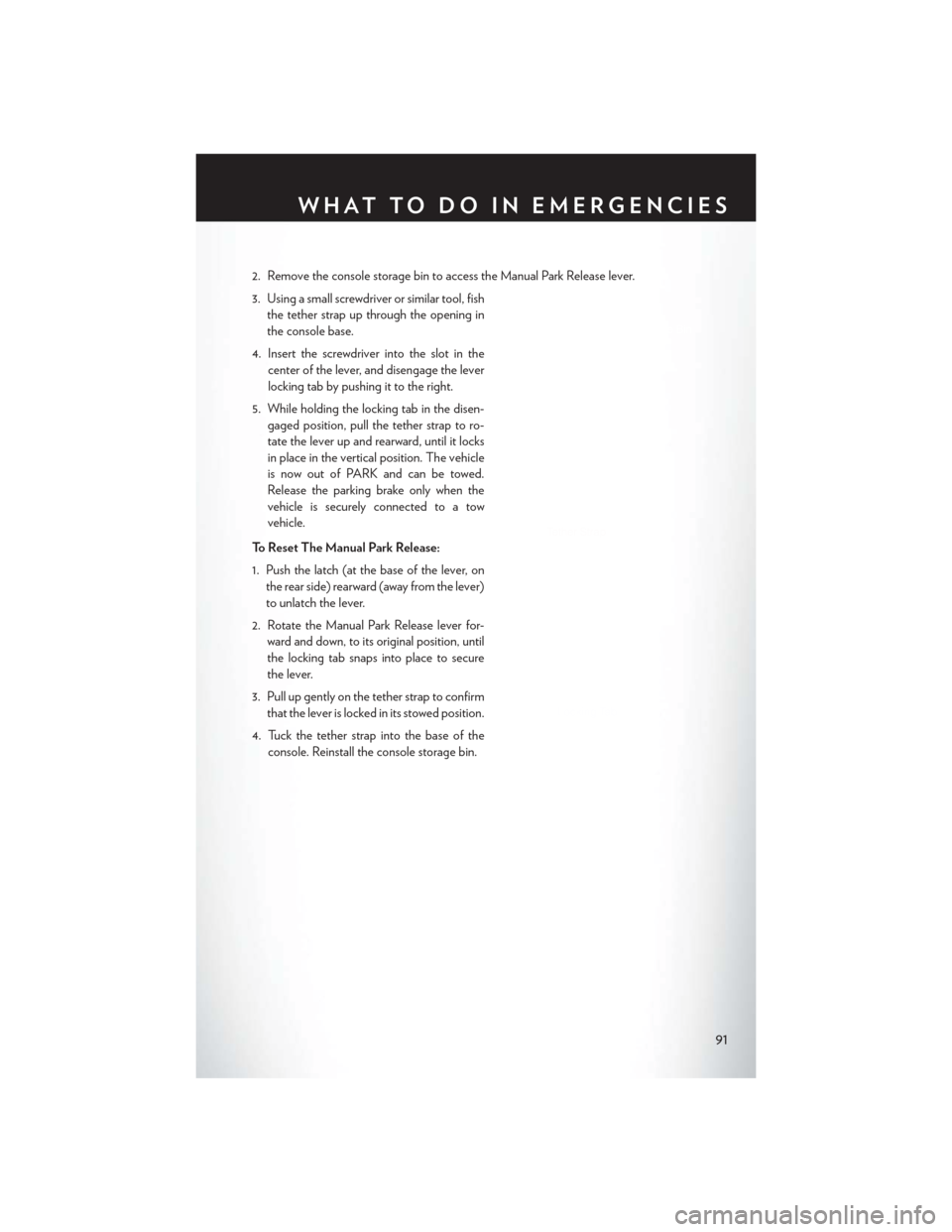CHRYSLER 300 SRT 2014 2.G Owners Manual
Manufacturer: CHRYSLER, Model Year: 2014, Model line: 300 SRT, Model: CHRYSLER 300 SRT 2014 2.GPages: 132, PDF Size: 4.64 MB
Page 91 of 132

2. Disconnect the negative end(-)of the jumper cable from the negative (-)post of the booster
battery.
3. Disconnect the opposite end of the positive (+)jumper cable from the positive (+)post of the
booster battery.
4. Disconnect the positive (+)end of the jumper cable from the remote positive (+)post of the
discharged vehicle.
NOTE:
If frequent jump-starting is required to start your vehicle you should have the battery and
charging system inspected at your authorized dealer.
CAUTION!
• Do not use a portable battery booster pack or any other booster source with a system voltage greater than 12 Volts or damage to the battery, starter motor, alternator or
electrical system may occur.
• Failure to follow these procedures could result in damage to the charging system of the booster vehicle or the discharged vehicle.
• Accessories that can be plugged into the vehicle power outlets draw power from the vehicle’s battery, even when not in use (e.g., cellular phones, etc.). Eventually, if plugged in
long enough, the vehicle’s battery discharges sufficiently to degrade battery life and/or
prevent the engine from starting.
WARNING!
• When temperatures are below the freezing point, electrolyte in a discharged battery mayfreeze. Do not attempt jump-starting because the battery could rupture or explode and
cause personal injury. Battery temperature must be brought above freezing point before
attempting a jump-start.
• Take care to avoid the radiator cooling fan whenever the hood is raised. It can start anytime the ignition switch is on. You can be injured by moving fan blades.
• Remove any metal jewelry, such as watch bands or bracelets, that might make an
inadvertent electrical contact. You could be severely injured.
• Batteries contain sulfuric acid that can burn your skin or eyes and generate hydrogen gas
which is flammable and explosive. Keep open flames or sparks away from the battery.
• Do not allow vehicles to touch each other as this could establish a ground connection and personal injury could result.
• Failure to follow this procedure could result in personal injury or property damage due to battery explosion.
• Do not connect the cable to the negative post (-)of the discharged battery. The resulting
electrical spark could cause the battery to explode and could result in personal injury.
WHAT TO DO IN EMERGENCIES
89
Page 92 of 132

SHIFT LEVER OVERRIDE — 5 SPEED
TRANSMISSION
• If a malfunction occurs and the shift levercannot be moved out of the PARK position,
you can use the following procedure to tem-
porarily move the shift lever:
1. Turn the engine OFF.
2. Firmly apply the parking brake.
3. Remove the rubber liner from the storage tray (located next to the shift lever on the
center console).
4. Press and maintain firm pressure on the brake pedal.
5. Insert a screwdriver or similar tool into the access port (in the left side of the storage
bin), and push and hold the override release lever in.
6. Move the shift lever to the NEUTRAL position.
7. The vehicle may then be started in NEUTRAL.
8. Reinstall the rubber storage bin liner.
MANUAL PARK RELEASE — 8 SPEED TRANSMISSION
WARNING!
Always secure your vehicle by fully applying the parking brake, before activating the Manual
Park Release. Activating the Manual Park Release will allow your vehicle to roll away if it is not
secured by the parking brake or by proper connection to a tow vehicle. Activating the Manual
Park Release on an unsecured vehicle could lead to serious injury or death for those in or
around the vehicle.
• In order to push or tow the vehicle in cases where the transmission will not shift out of PARK (such as a dead battery), a Manual Park Release is available. Follow these steps to use the
Manual Park Release:
1. Firmly apply the parking brake.
WHAT TO DO IN EMERGENCIES
90
Page 93 of 132

2. Remove the console storage bin to access the Manual Park Release lever.
3. Using a small screwdriver or similar tool, fishthe tether strap up through the opening in
the console base.
4. Insert the screwdriver into the slot in the center of the lever, and disengage the lever
locking tab by pushing it to the right.
5. While holding the locking tab in the disen- gaged position, pull the tether strap to ro-
tate the lever up and rearward, until it locks
in place in the vertical position. The vehicle
is now out of PARK and can be towed.
Release the parking brake only when the
vehicle is securely connected to a tow
vehicle.
To Reset The Manual Park Release:
1. Push the latch (at the base of the lever, on the rear side) rearward (away from the lever)
to unlatch the lever.
2. Rotate the Manual Park Release lever for- ward and down, to its original position, until
the locking tab snaps into place to secure
the lever.
3. Pull up gently on the tether strap to confirm that the lever is locked in its stowed position.
4. Tuck the tether strap into the base of the console. Reinstall the console storage bin.
WHAT TO DO IN EMERGENCIES
91
Page 94 of 132

TOWING A DISABLED VEHICLEModelFlat Towing (all four wheels
on the ground) Flatbed Towing (all four
wheels suspended OFF the
ground)Front Wheels Raised, Rear
Wheels on the Ground
Rear Wheels Raised, Front
Wheels on the Ground
RWD
Without a Key NOT Permitted Recommended Method NOT Permitted NOT Permitted
RWD
With a Key If transmission is operable:
•
Transmission in NEUTRAL
• 30 mph (48 km/h) max
speed
•
15 miles (24 km) max distance
(5–speed transmission)
•
30 miles (48 km) max distance
(8–speed transmission)
Recommended Method If transmission is operable:
• Transmission in NEUTRAL
• 30 mph (48 km/h) max
speed
•
15 miles (24 km) max distance
(5–speed transmission)
•
30 miles (48 km) max distance
(8–speed transmission)
OK
AWD
Without a Key NOT Permitted Recommended Method NOT Permitted NOT Permitted
AWD
With a Key NOT Permitted Recommended Method NOT Permitted •
Ignition in ON/RUN position
• Transmission in NEUTRAL
(Not in PARK)
Refer to your Owner’s Manual on the DVD for further information.
WHAT TO DO IN EMERGENCIES
92
Page 95 of 132

FREEING A STUCK VEHICLE
• If your vehicle becomes stuck in mud, sand or snow, it can often be moved using a rockingmotion. Turn the steering wheel right and left to clear the area around the front wheels. Then,
shift back and forth between REVERSE and DRIVE, while gently pressing the accelerator.
Use the least amount of accelerator pedal pressure that will maintain the rocking motion,
without spinning the wheels or racing the engine.
NOTE:
Press the "ESC Off" switch, to place the Electronic Stability Control (ESC) system in "Partial
Off" mode, before rocking the vehicle. Once the vehicle has been freed, press the "ESC Off"
switch again to restore "ESC On" mode.
CAUTION!
• When “rocking” a stuck vehicle by shifting between REVERSE and DRIVE, do not spin the wheels faster than 15 mph (24 km/h), or drivetrain damage may result.
• Revving the engine or spinning the wheels too fast may lead to transmission overheating
and failure. It can also damage the tires. Do not spin the wheels above 30 mph (48 km/h)
while in gear (no transmission shifting occurring).
WARNING!
Fast spinning tires can be dangerous. Forces generated by excessive wheel speeds may cause
tire damage or failure. A tire could explode and injure someone. Do not spin your vehicle's
wheels faster than 30 mph (48 km/h) when you are stuck. Do not let anyone near a spinning
wheel, no matter what the speed.
EVENT DATA RECORDER (EDR)
• This vehicle is equipped with an Event Data Recorder (EDR). The main purpose of an EDR is
to record, in certain crash or near crash-like situations, such as an air bag deployment or hitting
a road obstacle, data that will assist in understanding how a vehicle’s systems performed. The
EDR is designed to record data related to vehicle dynamics and safety systems for a short
period of time, typically 30 seconds or less. The EDR in this vehicle is designed to record such
data as:• How various systems in your vehicle were operating.
• Whether or not the driver and passenger safety belts were buckled/fastened.
• How far (if at all) the driver was depressing the accelerator and/or brake pedal.
• How fast the vehicle was traveling.
• These data can help provide a better understanding of the circumstances in which crashes and injuries occur.
WHAT TO DO IN EMERGENCIES
93
Page 96 of 132

NOTE:
EDR data is recorded by your vehicle only if a non-trivial crash situation occurs; no data is
recorded by the EDR under normal driving conditions and no personal data (e.g. name, gender,
age, and crash location) is recorded. However, other parties, such as law enforcement, could
combine the EDR data with the type of personally identifying data routinely acquired during a
crash investigation.
• To read data recorded by an EDR, special equipment is required, and access to the vehicle orthe EDR is needed. In addition to the vehicle manufacturer, other parties such as law
enforcement, that have the special equipment, can read the information if they have access to
the vehicle or the EDR.
WHAT TO DO IN EMERGENCIES
94
Page 97 of 132

OPENING THE HOOD
•Pull the hood release lever located on the
instrument panel, below the headlight switch.
• Raise the hood and locate the safety catch lever, in the middle of the hood opening.
• Push the safety catch lever to the left while lifting the hood at the same time.
WARNING!
Be sure the hood is fully latched before driving your vehicle. If the hood is not fully latched, it
could open when the vehicle is in motion and block your vision. Failure to follow this warning
could result in serious injury or death.
FUEL DOOR RELEASE
• The fuel door release button is located inthe driver's door map pocket.
• Push the button once and release to open the fuel door.
MAINTAINING YOUR VEHICLE
95
Page 98 of 132

Fuel Door Emergency Release
• To manually open the fuel door, remove thecover and pull the release cable located in
the trunk.
Emergency Refueling
•A funnel is provided (located in the trunk in
the spare tire area) to open the flapper door to
allow for emergency refueling with a gas can.
CAUTION!
To avoid fuel spillage and overfilling, do not “top off ” the fuel tank after filling.
WARNING!
• Never have any smoking materials lit in or near the vehicle when the fuel door is open or
the tank is being filled.
• Never add fuel when the engine is running. This is in violation of most state and federal fire
regulations and/or local bylaws, and will cause the MIL to turn on.
• A fire may result if gasoline is pumped into a portable container that is inside of a vehicle.
You could be burned. Always place gas containers on the ground while filling.
MAINTAINING YOUR VEHICLE
96
Page 99 of 132

ENGINE COMPARTMENT3.6L Engine
MAINTAINING YOUR VEHICLE
97
Page 100 of 132

5.7L Engine
MAINTAINING YOUR VEHICLE
98